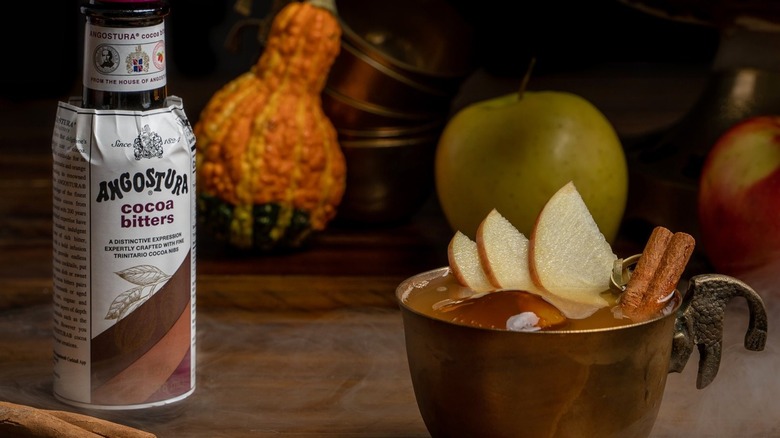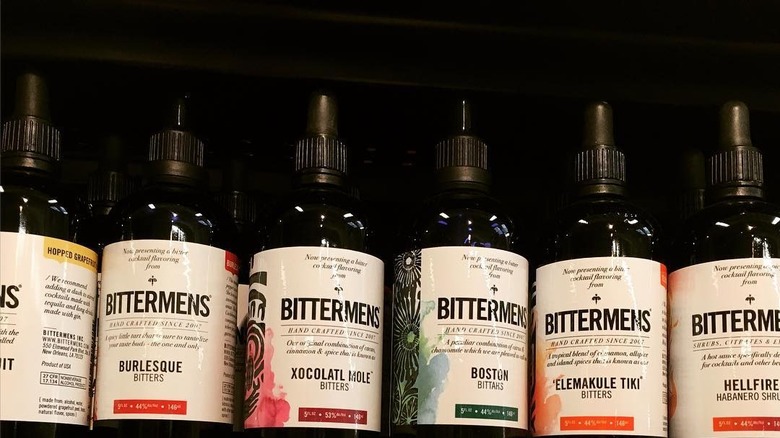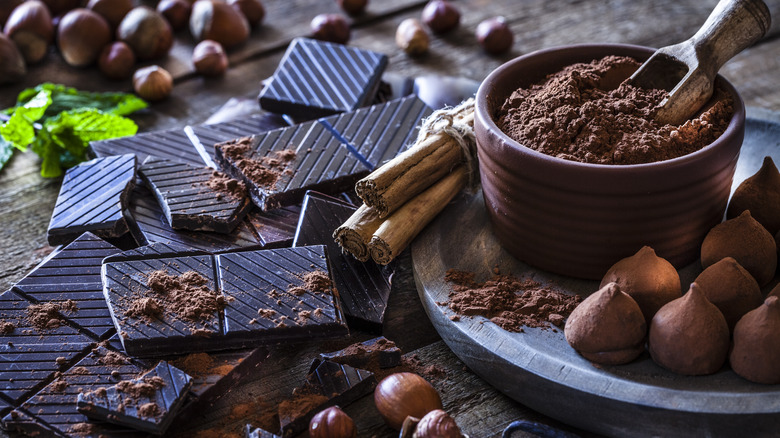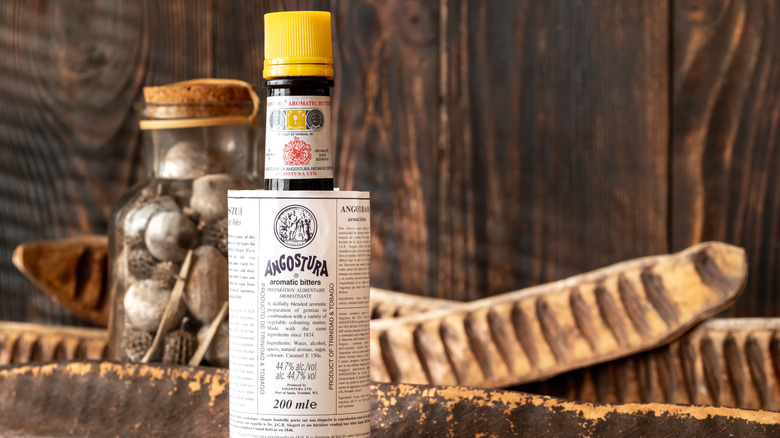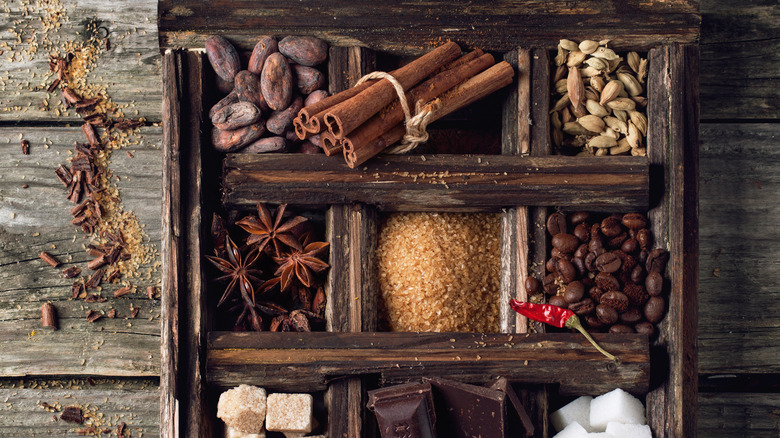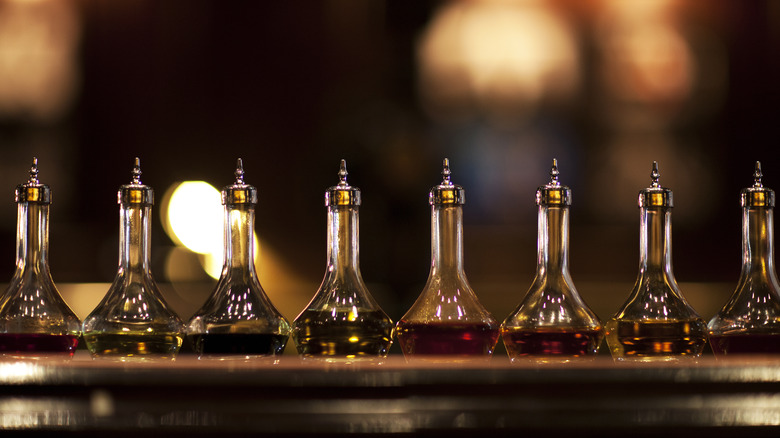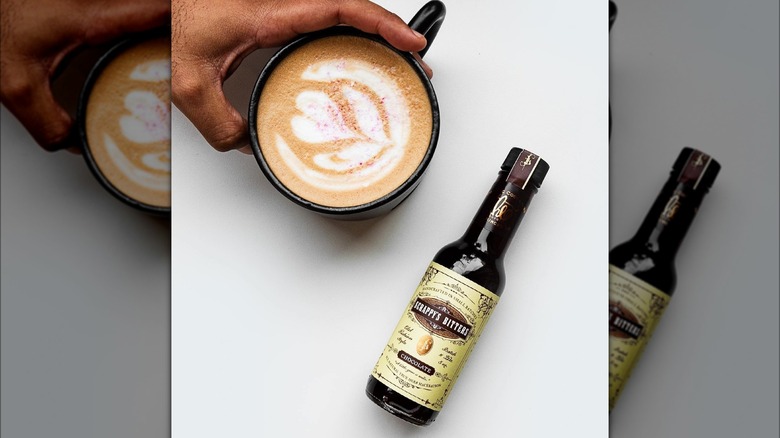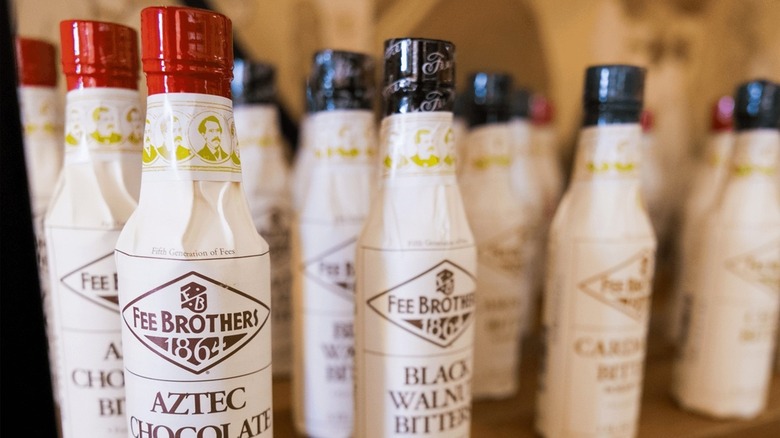What Are Cocoa Bitters And How Do You Use Them?
We may receive a commission on purchases made from links.
Any well-stocked bar should have at least one bottle of bitters: a staple ingredient in cocktails since the early 19th century. The ingredient has made a roaring comeback in the modern cocktail revolution as a mixologist's flavor-enhancing tool.
So what exactly are bitters? Bitters are highly concentrated liquid extracts made by infusing high-proof, neutral-flavored alcohol with botanicals like flowers, citrus peels, herbs, and spices. Potent in flavor, this elixir comes in small glass bottles with a dropper to carefully add a controlled amount to a chosen recipe. Just a few drops can enhance the flavor profile of any cocktail and add a floral, nutty, or herbaceous essence. Bitters transform the most novice bartender into a refined mixologist who can wow a crowd with their cocktails.
You may have heard of Angostura bitters, Peychaud's bitters, black walnut bitters, and orange bitters. But cocoa bitters are indeed a class of their own. This dark, rich, and cacao-forward spin on the classic Angostura bitters is a match made in heaven for chocolate lovers. The profile of cocoa bitters — which are sometimes marketed as chocolate bitters — is complex, with notes of dark chocolate, cinnamon, and spices. A dash of cocoa bitters will add warmth to your favorite cocktails, a chocolaty twist to your morning cup of coffee, or a hint of cocoa to your favorite cookie recipe. It's a fun and versatile ingredient to add to your kitchen for all things chocolate.
What are cocoa bitters and what's the history behind them?
Cocoa bitters first hit the scene in 2007 when popular bitters producer Bittermens launched its Xocolatl Mole Bitters. This decadent, chocolaty bitters, featuring cacao, cinnamon, and spice, is inspired by the dynamic flavors of Mexican cuisine. To make this concoction, the company blends cacao nibs, cinnamon, cardamom, vanilla, and other spices with high-proof alcohol. The result is a rich, spice-forward extract that adds an abundance of flavor to cocktails — or to recipes from marinades to brownies.
Bittermens Xocalatl Mole bitters was crafted to blend it with aged tequila, but it also integrates smoothly with bourbon, rye, and aged rum. Since its launch, the trend of cocoa bitters has caught on and caused other producers to make their own versions of cocoa bitters or chocolate bitters. Despite the differing names, chocolate and cocoa bitters contain more or less the same ingredients: bitters centered around cacao and warm spices.
While it may not hold the same widespread popularity and use as angostura bitters, cocoa bitters still have a massive appeal and are making more frequent appearances on elevated cocktail menus. Surely, in part, due to a universal love of chocolate.
What do cocoa bitters taste like?
Bitters come in many flavor variations, from nutty to floral, citrus to herbaceous. Each bitters reflects the unique blend of botanicals infused with the alcohol. The flavor profile of cocoa bitters, which is made with cacao nibs, is rich, complex, and nutty, with notes of dark chocolate and warm spices.
While cocoa bitters have subtle dark chocolate characteristics, it is not overly sweet like a commercial chocolate bar. So, the bitters retain the strong flavor characteristics of the cacao nibs with a hint of bitterness. Beyond the cacao profile, the nuanced undertones vary depending on the brand of cocoa bitters. Cocoa bitters are made with the same base ingredients across producers, but there is a decent amount of variety in recipes and additional ingredients that go beyond cacao nibs. For example, some brands land on the sweeter side, others are more bitter, and a few include a spicy kick. Each variation has its merits and caters to a range of palates, which offers seemingly limitless potential for culinary experimentation.
Angostura bitters vs. cocoa bitters
Angostura bitters hold the title of the most widely used bitters on the market after being created in 1824. Well-timed with the rise of the golden age of cocktails, bitters soon became a crucial element in the rising cocktail culture. Two centuries later, these bitters remain a key ingredient in some of the world's most beloved beverages.
While Angostura has now established itself as a brand of bitters with many flavor variations – including chocolate — the classic Angostura bitters variety sits in a class of its own. Angostura bitters balance spicy and bitter, accompanied by hints of clove and cinnamon. Although cocoa bitters reflect some of the same spice notes, the distinct chocolate tones set it apart.
The spicy profile of Angostura bitters is a great addition to a range of cocktails. Angostura complements rather than distracts from the flavor profile of bourbon drinks like the old fashioned and Manhattan, where it plays on the spiced notes of the whiskey. Beyond the world of whiskey, Angostura is a fun addition to gin cocktails, tomato sauces, and meat marinades. Cocoa bitters also pair well with many of these drinks and food dishes. Despite sharing some similarities, Angostura and cocoa can't necessarily be used interchangeably. While Angostura bitters can blend seamlessly with cocktails and food by enhancing the flavors already there, cocoa bitters change the flavor profile more profoundly, bringing it in a darker, more chocolaty direction.
How are cocoa bitters made?
The production of cocoa bitters follows the same general steps that are required to make other types of bitters. Bitters are produced by infusing a neutral, high-proof alcohol with various botanicals. The liquor should be at least 50% alcohol by volume or 100 proof. This strength is important, as higher-proof spirits extract the flavor quicker. Neutral-flavored spirits like vodka, Everclear, or other grain alcohols tend to work best because the neutral flavor profile allows the essence of the infused spices, herbs, and shrubs to shine.
Cacao nibs, vanilla beans, cardamom pods, and cinnamon sticks are standard base ingredients that give the cocoa bitters its complexity. Gentian root, wild cherry bark, and black walnut leaf are other essential ingredients in the mixture used to embitter the alcohol. On top of the base ingredients, there is room for creativity depending on any additional flavors the maker requires. For example, orange peel adds a citrusy sweetness, while cayenne pepper can add a spicy pinch.
What are the best brands and where can you buy them?
Bitters can be found pretty much anywhere you buy spirits. Although you're unlikely to find cocoa bitters at your neighborhood grocery store, you may have better luck at specialty beverage stores. For example, Total Wine carries several versions of this chocolaty essence. If you're not up for a bitters-themed scavenger hunt around town, Amazon also carries a range of cocoa bitters.
Cocoa bitters are on the rise, with an increasing number of brands to choose from. Each cocoa bitters brand has a unique flavor profile, so your chosen bottle is mainly up to personal preference and how you intend to use it.
Fee Brothers Aztec Chocolate Bitters is a great entry cocoa bitters for first-time users. The lighter milk chocolate flavor with a touch of cinnamon is a subtle addition to most cocktails. In contrast, Scrappy's Bitters Chocolate Bitters have bolder chocolate notes. These bitters are reminiscent of a gooey dark chocolate lava cake with hints of vanilla and spice and are perfect in cocktails with caramel and berry flavors. True dark chocolate lovers may opt for the original Bittermens Xocolatl Mole Bitters, with an unsweetened dark chocolate and cinnamon profile enshrouded with earthy notes. This bottle is a perfect companion to dark rum or aged tequila.
Purchase Fee Brothers Aztec Chocolate Bitters on Amazon for $12
Purchase Scrappy's Bitters Chocolate Bitters on Amazon for $19.79
Purchase Bittermens Xocolatl Mole Bitters on Amazon for $22.92
Make cocoa bitters at home
Cocoa bitters can be DIY-ed — not just bought from an online retailer. Whether you're a kitchen whizz or a novice cook, making cocoa bitters is quite straightforward with the right ingredients and a touch of creativity.
Different variations of cocoa bitters recipes exist, but each starts with high-quality, high-proof alcohol. While neutral-flavored, light alcohol is usually recommended, some home recipes also use a high-proof whiskey. The rich spices of a whiskey complement the infused botanicals in cocoa bitters, creating a tasty, warm elixir. After you've chosen your alcohol, the next essential ingredient is cacao nibs, which give the bitters its cocoa profile. From there, you can experiment with spices like cinnamon, vanilla, cardamom, wild cherry bark, and black walnut leaf to make your bitters unique.
With all ingredients on hand, it is now time to steep the botanicals and alcohol in a sealable glass jar. Although you may be tempted to throw everything in at once, spices and botanicals infuse at different rates, so you may need to add ingredients at different stages. On average, the concoction should steep for about two weeks total.
Shake the jar once a day and watch as the liquid gradually becomes darker. After the infusion is complete, separate the botanicals from the liquid using a cheesecloth and transfer the liquid to a dropper bottle. Then, it's time to whip up a cocktail and enjoy the magic!
Cocoa bitters enhance cocktails
The most classic use of cocoa bitters is to add a few drops into a cocktail. These chocolaty bitters are a great way to upgrade bourbon on the rocks or other whiskey-based libations. Start simple and add a few drops to a Manhattan or a smooth old fashioned. You'll also find these bitters complementing ryes and bourbons, including modern cocktails like a rum and absinthe drink called the Latin Quarter.
When you're ready to get more adventurous, cocoa bitters are also a perfect pairing with coffee-based cocktails. Think of drinks like espresso grog, a mocha martini, or a Squeaky Wheel, which is essentially a mezcal and coffee negroni. A few dashes of cocoa bitters also blend seamlessly into a Vieux Carre: an enticing blend of Benedictine, sweet vermouth, cognac, and rye whiskey.
When you're ready to get even more crafty, dream up creations like a chocolate mojito and a mole margarita. While not an obvious choice, cocoa bitters pair well with aged tequila and rum in these beverages. You can also use cocoa bitters in combination with other bitters. A few dashes of cherry bitters and a couple of drops of cocoa bitters mixed with a smoked whisky make a dangerously delicious bourbon beverage that will have you dreaming of chocolate-covered cherries.
Cocoa bitters enhance other recipes too
While your first thought may be to add cocoa bitters into libations, it can be used in more than just cocktails. Any food or drink that benefits from warm, earthy, spice-forward notes — and a hint of chocolate — can benefit from cocoa bitters.
Add a splash into your morning coffee to give it some spice and cocoa flavor. Mole sauce, a traditional Mexican ingredient used for dishes like enchiladas and chicken, already has chocolaty and spicy notes that can be furthered with cocoa bitters. The same goes for barbeque sauces that can benefit from a splash of these uniquely-flavored bitters. If you're eager to turn up the creativity a notch in the kitchen, add some cocoa bitters to your favorite chili recipe or even a couple of drops on top of a bowl of pumpkin soup to play with sweet, spicy, and earthy flavors.
The versatility of cocoa bitters also extends into the world of baking. Add a few drops into brownie batter, chocolate chip cookies, scones, or sugar cookies for a hint of chocolate to offset the sweetness. Or, switch up your classic whipped cream with a few drops of cocoa bitters and add it to the top of a mug of hot chocolate. Cococa bitters are easy to use and hard to go wrong with.
How do you store cocoa bitters?
Just like other types of bitters, cocoa bitters have a long shelf life because it is made with high-proof alcohol. Thanks to alcohol being both an antimicrobial and a preservative, you don't have to worry about your bitters spoiling overnight. In some respects, the shelf-life of bitters is more or less indefinite.
An open bottle of bitters will last about five years. The product won't necessarily have spoiled, but after this point, the bitters start to lose potency and the flavor fades. This is mainly due to oxidation and evaporation. To help preserve your bitters, make sure to keep the lid screwed on tightly and store the bottle in a cool, dry place away from direct sunlight. Keeping it in a refrigerator isn't necessary, but it also won't hurt your bitters. Store-bought bitters should come in a dark glass bottle, which helps protect it from light. If you make your own bitters, opt for dark glass versus clear to extend its shelf-life.
